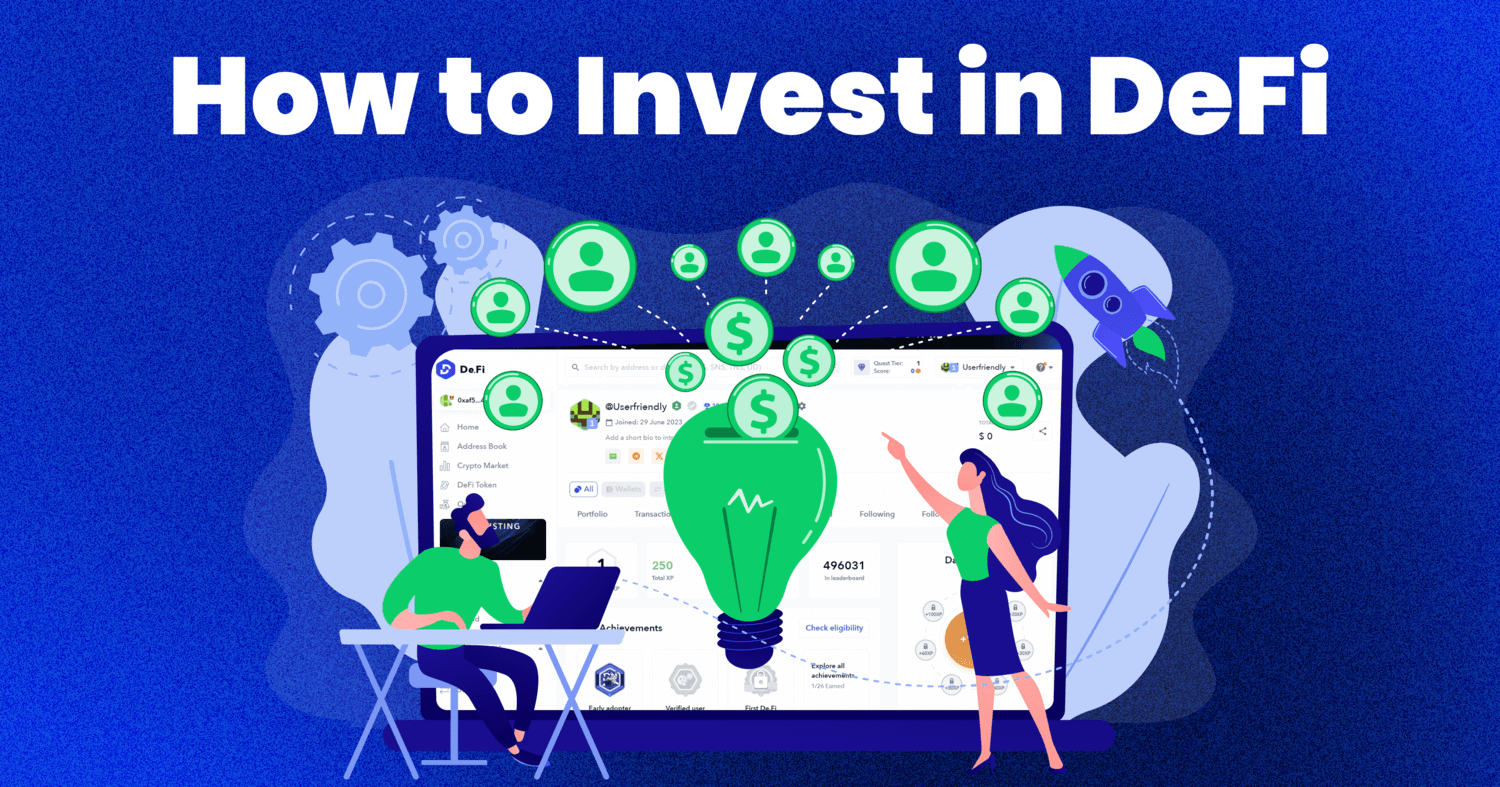When you start searching for how to invest in DeFi, you will discover various DeFi platforms, which can make it difficult to proceed. Fortunately, this article covers the five best ways to invest in DeFi projects, a step-by-step guide, and the pros and cons associated with this investment option. Now, let’s get to it!
Key Takeaways
- Decentralized finance (DeFi) is an emerging financial technology that uses smart contracts to facilitate peer-to-peer (P2P) transactions without a central authority like in a centralized financial system.
- The five best DeFi investment strategies are asset trading, staking DeFi tokens, Index Tokens, Lending, and Yield farming.
- Investing in DeFi projects gives users full control of their assets and provides opportunities for constant rewards and yield generation.
What Is DeFi?
![How to Invest in DeFi: A Step-by-Step Guide ([currentyear]) 2 what is defi](https://coinwire.com/wp-content/uploads/2024/10/what-is-defi-1024x576.jpg)
DeFi is an improved alternative to centralized financial institutions designed to aid peer-to-peer transactions through smart contracts. The DeFi space operates on Blockchain technology and aims to increase accessibility to financial services. This is why decentralized finance platforms are available round the clock for various services, like lending and trading.
In addition, DeFi enables users to interact with decentralized applications (dApps) while maintaining full control over their digital assets. Let’s dive into the ways in which you can securely invest in DeFi.
5 Best Ways to Invest in DeFi
Having discussed what decentralized finance is, here is a rundown of the five best ways to invest in decentralized finance.
1. DeFi Asset Trading
One of the easiest ways to invest in DeFi is by buying DeFi tokens and trading them on decentralized exchanges (DEXs). For asset trading on DeFi, you can choose any DeFi protocol, the amount you want to trade, and the specific network.
Once you confirm your trade, automated market makers (AMMs) are deployed to facilitate the swap by drawing from liquidity pools funded by other DeFi investors. Some top DeFi protocols to choose from are Avalanche, Chainlink, Uniswap, Stacks, Aave, and Fantom.
2. DeFi Indexes Token
DeFi indexes are designed to track the performance of other assets across the DeFi landscape. Some popular examples include the DeFi Pulse Index (DPI), sDEFI, and DEFI5. Take the DEFI5 Index, for example. It tracks the top five DeFi tokens by market capitalization, automatically rebalancing to include them in the index.
Another example is the DeFi Pulse Index, which tracks the largest DeFi projects also based on circulating supply value. What makes DeFi Index Tokens a convenient investment strategy is that when you buy an index like DPI, you own a share of it. DPI’s investment managers then handle the allocation across top DeFi assets.
3. DeFi Lending
On DeFi lending platforms, you can deposit your crypto holdings into a lending pool, which is then made available to borrowers. These platforms use smart contracts to govern the terms of the loans, including interest rates and repayment schedules, based on supply and demand.
![How to Invest in DeFi: A Step-by-Step Guide ([currentyear]) 3 defi lending](https://coinwire.com/wp-content/uploads/2024/10/defi-lending-1024x592.jpg)
For instance, using a DeFi platform like AAVE or MarkerDao allows you to choose which token you want to deposit in the lending pool. Once you deposit in a chosen money market, you will receive newly minted native tokens like AToken for AAVE and DAI for MarkerDao that are equivalent to your original deposit and additional interest.
DeFi platforms offer various types of loans, and they include:
- Over-collateralized Loans: Here, borrowers provide collateral in crypto that exceeds the value of the loan—often between 150% to 300% of the loan amount—to protect lenders’ funds in case the borrower does not redeem their loan.
- Flash Loans: Unlike the other two options, flash loans do not require collateral but they must be paid back within a single transaction block. If they do not repay, the smart contract will reverse all financial transactions.
- Under-collateralized Loans: Some platforms are exploring methods to allow under-collateralized loans by assessing creditworthiness through decentralized identities or reputation systems.
4. DeFi Staking
DeFi staking requires you to lock your digital assets within a smart contract to support the network’s operations in return for staking rewards. If you are considering DeFi staking, some of the benefits you should expect are higher returns, the ability to contribute to the security of the network, liquidity, and the flexibility to unstake your tokens whenever you want.
These are the different ways to participate in DeFi staking.
- Liquidity Staking: Users can receive rewards by staking tokens in Proof of Stake (PoS) networks while simultaneously participating in other DeFi activities.
- Validator Staking: This involves staking tokens to participate in decision-making processes within a blockchain network, granting holders voting rights on protocol changes.
- Governance Staking: Requires users to lock their tokens to become validators, directly securing the network and earning rewards. But this DeFi staking method demands a significant minimum investment and technical know-how.
5. DeFi Yield Farming
DeFi yield farming has become one of the top ways to earn passive income in the DeFi ecosystem. Yield farming involves depositing tokens into a liquidity pool on a DeFi protocol for a set timeframe to earn rewards through governance tokens, transaction fees, or newly minted tokens.
In some cases, the deposited assets become available to borrowers for other trading activities. In the case of DEXs powered by an AMM, they are used to provide liquidity to facilitate ‘buy’ and ‘sell’ orders. Yield farming is available to anyone on various networks on blockchain technology, especially the Ethereum network, using ERC-20 tokens.
How to Invest in DeFi: A Step-by-Step Guide
Now that we’ve reviewed ways to invest in decentralized finance, here is a step-by-step guide on how to invest in DeFi and earn additional rewards.
1. Prepare a Wallet
To trade DeFi coins or invest in the DeFi landscape, you need to choose a good DeFi wallet. If you are unsure what wallet to use, check out our list of the 11 best DeFi wallets in 2024 and opt for any of the wallets on the list.
2. Purchase Crypto Coins
Once you set up your wallet, the next step is to purchase crypto like Bitcoin (BTC), Ethereum (ETH), Solana (SOL), or any other crypto tokens of your choice. It helps if the wallet you choose also has an in-app exchange interface like in Coinbase or Binance. If your wallet does not have an exchange interface, you can buy crypto from any zero-fee exchange and transfer the crypto to your DeFi wallet.
3. Get Started With Protocols
Explore various protocols and DeFi platforms and pick one for trading, staking, yield farming, or lending based on your needs. To begin:
- Visit the protocol’s website or mobile app.
- Select the Blockchain network you want to use for your DeFi investments (Ethereum, Optimism, Base, or Polygon).
- Link your crypto wallet or exchange to the DeFi protocol of your choice so they can access your coins. Ensure the decentralized finance platform you opt for supports your wallet.
- Follow the next instructions on the DeFi app to start investing.
4. Track Your DeFi Investments
Use crypto portfolio trackers to check your DeFi investment across multiple chains regularly. These platforms will help you keep an eye on DeFi token holdings and market trends. They will also help you track trades and staking activities, as well as changes in your investments.
Pros and Cons of Investing in DeFi
While investing in DeFi decentralized finance has multiple benefits, it is also risky. Here are the pros and cons of putting money into DeFi to help you make informed decisions.
Pros of Investing in DeFi
- Accessibility: Anyone with an internet connection and a crypto wallet can use DeFi platforms.
- High Returns: You can potentially earn high returns of up to 5-30% on deposits annually in the DeFi space, especially if you buy and sell at the right time.
- Portfolio Diversification: With decentralized finance protocols, you can diversify your DeFi portfolio using asset trading, index tokens, yield farming, staking, and lending.
- Autonomy and Control: Unlike traditional financial institutions, you have full control over your assets, and you can invest without relying on an intermediary or central authority.
Cons of Investing in DeFi
- Market Volatility: Cryptocurrencies are highly volatile and this instability can result in substantial losses, especially for collateralized loans.
- Scams: The DeFi space is unregulated, increasing risks of fraud and scams.
- User Error: Not many people understand decentralized finance, and even those who are familiar with it can make mistakes, such as sending funds to the wrong address.
Conclusion: Is DeFi a good Investment?
While DeFi investing offers tons of opportunities for earnings, it also has significant risks. If you decide to invest, you will benefit from low fees, increased accessibility, transparency, and the potential for higher returns. However, you must also navigate market volatility and DeFi scams. So, weigh your risk tolerance level before investing in DeFi.
Elevate your crypto trading career with CoinWire Trading signals. Get Premium daily signal calls, trading insight, updates about the current market, and analytics about hidden crypto gems now.






